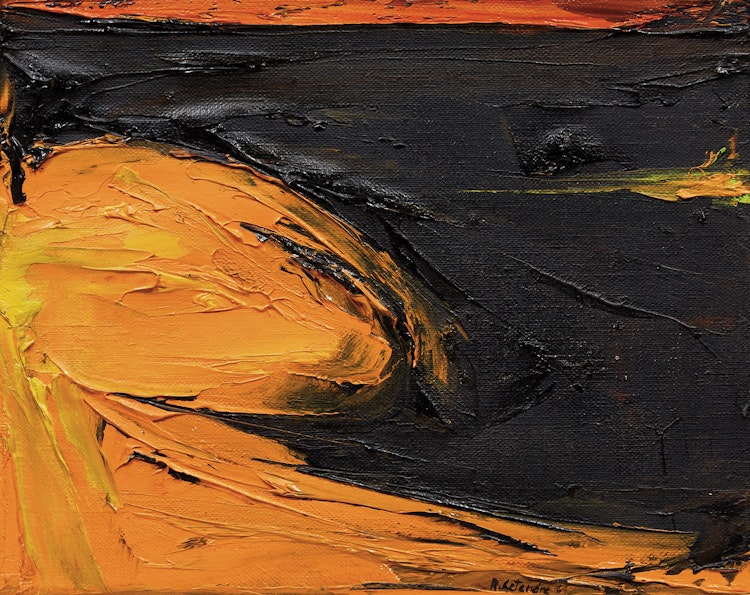Envol by Rita Letendre

Rita Letendre
Envol
oil on canvas
signed and dated 1964 lower right
8.25 x 10 ins ( 21 x 25.4 cms )
Auction Estimate: $7,000.00 - $9,000.00
Price Realized $13,200.00
Sale date: December 3rd 2020
Galerie Agnès Lefort, Montreal
Private Collection, Stratford, Ontario
Private Collection, Toronto
movement. Using a variety of applicators, Letendre fluctuated between brush and spatula to apply thick layers of paint to achieve varying textures on the canvas, always mindful of the gesture of the artist’s hand moving the paint.
As the Automatistes and its affiliates began to abandon their commitment to spontaneity in favour of control and structure, Letendre painted into the mid-1960s maintaining a gestural abstraction. Dramatic and evocative, “Envol’s” bright yellow form curves upward into the left side of the canvas, creating energy that emerges from the immersive dark background. The title of the piece translates to “flight”, perhaps alluding to the upward-moving energy emerging from the base of the canvas. Letendre kept a fairly consistent palette of dramatic colours, often with large swaths of black, until the mid-1960s when she made the decisive shift into geometric compositions.
Share this item with your friends
Rita Letendre
(1928 - 2021) RCA
Canadian painter, muralist, and printmaker Rita Letendre was born in Drummondville, Quebec, in 1928. She is of Iroquois descent. Letendre and her parents moved to Montreal in 1941. She settled in Toronto in 1963. In part, Letendre is self-taught but she studied at the Ecole des Beaux-Arts in Montreal for year and a half. While in school she was introduced to the Automatistes due to pamphlets announcing the locations of their new paintings.
Encouraged by Borduas, Mosseau, and Ferron’s art, Letendre began exploring similar motifs in her paintings and began exhibiting with the group from 1952-55. In 1955 she exhibited in “Espace 1955” at the Montreal Museum of Fine Arts. Sharing a studio with fellow Automatiste painter and sculptor, Ulysse Comtois, Letendre became the subject of an article by the Weekend Magazine on non-objective Montreal-based painters. Then, in 1959, Letendre was included in the Third Biennial Exhibition of Canadian Art. In the following year the National Gallery of Canada included Letendre in their Non-Figurative Artists of Montreal exhibit that traveled throughout Canada. In 1962, Letendre received a travelling grant from the Canada Council and traveled to Paris, Italy, Israel, Spain, Belgium, and Germany.
Using a variety of techniques and media such as brush, spatula, pastel, silkscreen, and airbrush, Letendre was a leading member of the colourist movement. Exhibited in over sixty-five solo exhibitions, Letendre’s work can be described in three distinct periods. Her first period, known as the Montreal years, was inspired by her first meeting with Borduas and was a rich exploration of self-discovery. Letendre’s second period was inspired by Russian-born sculptor Kosso Eloul, who later became her husband. Her final period was rooted in mourning and love.
Letendre’s works vary in size from grand murals that are sixty feet by sixty feet in size to small projects on silkscreen. These works are collected throughout the North American continent by governments and public and private galleries and organizations. Letendre’s work has been exhibited in Europe, Israel, Japan, and throughout North America in New York City, Los Angeles, San Francisco, Detroit, Montreal, Toronto, and Vancouver.
Literature Sources:
"A Dictionary of Canadian Artists, Volume II”, compiled by Colin S. MacDonald, Canadian Paperbacks Publishing Ltd, Ottawa, 1979
Roumanes, Jacques-Bernard. “Rita Letendre: Le tableau ivre.” Vie des Arts 45, 183, 2001
Andersen, Marguerite. “Rita Letendre: Énergie et luminosité. L’art du féminin, 12 2004
We extend our thanks to Danie Klein, York University graduate student in art history, for writing and contributing this artist biography.

